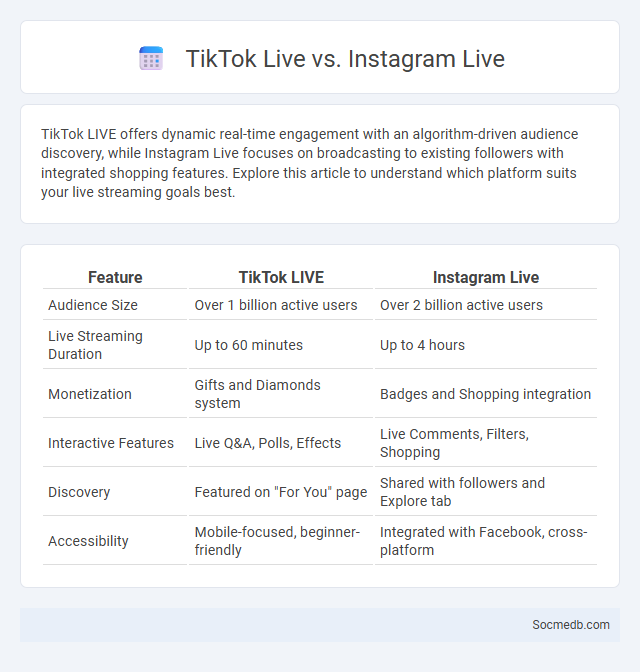
Photo illustration: TikTok LIVE vs Instagram Live
TikTok LIVE offers dynamic real-time engagement with an algorithm-driven audience discovery, while Instagram Live focuses on broadcasting to existing followers with integrated shopping features. Explore this article to understand which platform suits your live streaming goals best.
Table of Comparison
| Feature | TikTok LIVE | Instagram Live |
|---|---|---|
| Audience Size | Over 1 billion active users | Over 2 billion active users |
| Live Streaming Duration | Up to 60 minutes | Up to 4 hours |
| Monetization | Gifts and Diamonds system | Badges and Shopping integration |
| Interactive Features | Live Q&A, Polls, Effects | Live Comments, Filters, Shopping |
| Discovery | Featured on "For You" page | Shared with followers and Explore tab |
| Accessibility | Mobile-focused, beginner-friendly | Integrated with Facebook, cross-platform |
Introduction to Social Media Livestreaming Platforms
Social media livestreaming platforms such as Twitch, YouTube Live, and Facebook Live have revolutionized real-time content sharing by enabling creators to engage directly with their audiences worldwide. These platforms support interactive features like live chat, virtual gifts, and real-time reactions that enhance viewer participation and community building. Understanding how to maximize your presence on these livestreaming services can significantly increase your brand visibility and audience engagement.
TikTok LIVE: Features and Benefits
TikTok LIVE offers real-time interaction, enabling you to connect directly with your audience through live video broadcasts. This feature supports instant comments, virtual gifts, and collaborative streams, enhancing audience engagement and community building. Leveraging TikTok LIVE can significantly boost your visibility and foster authentic connections with followers.
Instagram Live: Features and Benefits
Instagram Live offers real-time video broadcasting that enables users to engage directly with their audience through live comments and reactions. Key features include interactive Q&A sessions, live shopping integration, and the ability to save broadcasts to IGTV for extended reach. Businesses benefit from increased transparency, enhanced community building, and immediate feedback, driving stronger brand loyalty and higher engagement rates.
Livestream: Unique Capabilities and Offerings
Livestream provides unique capabilities such as real-time audience interaction, enabling you to engage directly with viewers through live comments, polls, and Q&A sessions. Its seamless integration with multiple platforms enhances your reach, while advanced features like multi-camera support and high-definition streaming ensure professional-quality broadcasts. These offerings make Livestream an essential tool for brands and creators aiming to build authentic connections and maximize viewer engagement.
User Demographics and Audience Engagement
Social media platforms attract diverse user demographics, with Facebook leading in users aged 25-34, while TikTok dominates among Gen Z, primarily those aged 16-24. Audience engagement rates vary significantly, with Instagram reporting average interaction rates of 1.22% per follower, compared to Twitter's approximate 0.045%, indicating stronger visual content resonance. Marketers leverage these insights to tailor content strategies, enhancing targeted ad campaigns and user interaction metrics.
Monetization Options Across Platforms
Social media platforms offer diverse monetization options, such as ad revenue sharing on YouTube, sponsored posts on Instagram, and TikTok's Creator Fund. You can also explore affiliate marketing, merchandise sales, and subscription-based content on platforms like Facebook and Patreon. Leveraging these monetization tools effectively helps maximize your earnings and grow your online presence.
Streaming Quality and Technical Requirements
Streaming quality on social media platforms depends heavily on factors such as internet bandwidth, device capabilities, and platform encoding standards. Optimal technical requirements typically include a minimum upload speed of 5 Mbps for HD streaming, support for H.264 or H.265 video codecs, and adaptive bitrate streaming to ensure smooth playback without buffering. To enhance your viewers' experience, ensure your setup meets these specifications and regularly test your connection before live broadcasts.
Content Moderation and Safety Tools
Content moderation in social media platforms leverages AI algorithms and human review teams to detect and remove harmful, inappropriate, or misleading content, ensuring user safety and platform integrity. Advanced safety tools include real-time filtering, AI-driven image and video analysis, and user reporting mechanisms that enhance community standards enforcement. These technologies collectively reduce online harassment, misinformation, and hate speech, fostering a safer digital environment for billions of users worldwide.
Discoverability and Algorithm Support
Social media platforms use advanced algorithms to enhance content discoverability by analyzing user behavior, preferences, and engagement patterns. Algorithms prioritize content that generates high interaction rates, such as likes, comments, and shares, boosting visibility on feeds and recommendation sections. Optimizing posts with relevant keywords, hashtags, and consistent activity increases chances of algorithmic support, driving organic reach and audience growth.
Choosing the Right Platform for Your Goals
Selecting the right social media platform depends on understanding your target audience and specific business objectives. Platforms like Instagram and TikTok excel for visual and younger demographics, while LinkedIn targets professionals for B2B marketing. Analyzing platform features such as engagement rates, content formats, and ad tools ensures alignment with your brand's marketing strategy and maximizes reach.
 socmedb.com
socmedb.com